By Philip Uwaoma
It’s just a few days shy of a month since Cars and Horsepower reached out to Toyota for comments about the Camry’s availability in Nigeria come 2025. The Japanese automaker had long mentioned that the imperiled Camry would enter its 9th generation equipped with the company's newest HEV technology.
Though it's a relief that the popular midsize sedan will see its 9th generation, we weren't sure what the trajectory of the new car will look like and if that trajectory will lead to Nigeria's shores. If you don't see it already, I'll soon explain why the Camry's presence in Nigeria from 2025 is doubtful. We didn't find it funny when Toyota finally unveiled the 9th-gen 2025 Camry, relying exclusively on a hybrid powertrain for propulsion.
While the car is a hundred percent Nigeria's favorite sedan, the country doesn't feel the same way about hybrid technology. We asked three Toyota executives as well as Toyota Nigeria but got no answer on whether or not the hybrid 2025 Camry will be sold in Nigeria. Be as it may, the handwriting on the wall seems like a goodbye message to Nigeria, a mournful end of an era.
See also: Toyota Unveils TRD-Modified Camry XSE Race Car To Dominate The 2024 NASCAR Cup Series
Is It Time-Up For The Toyota Camry In Nigeria?
When a mainstream global brand like Toyota drops (and by that, we mean 'releases') a new product, we're always first in line to share the story. When the Japanese marque revealed the 2025 Camry on November 14, the Camry's special relationship with Nigeria prevented us from running a review immediately.
This is the brand - the only brand - that thick-skinned, proud Nigerians gladly nicknamed "Big Daddy." The other popular Japanese brand was just "Baby Boy," but the Camry qualified as "Big Daddy." What a special relationship.
Of course, we could write about the Camry for audiences outside Nigeria. In fact, America buys more than half of the Camry's total global sales.
Here's the thing. A good chunk of that number eventually find their way to this side of Africa, and in seven to ten years, more than half of the Toyota Camry models in North America would eventually end up in West African regions.
Just because America has the economic power to buy them new doesn't mean they love it as much as Nigerians do. The reasons for Nigeria's obsession with the Toyota Camry are near-existential - fuel economy, reliability, availability of parts, build quality and popularity.
Nigeria's special connection to the Camry compelled us to hold our pen and wait anxiously for weeks after the 9th-gen Camry was unveiled. We just had to hear from Toyota because we wouldn't write about this Camry without using green-white-green paper.
Toyota is already pulling the plug on the Camry in some markets - Japan, specifically. 2023 is the Toyota Camry's last year in Japan, and it looks like Nigeria is next, just without the fanfare. Toyota is discontinuing the Camry in Japan due to declining demand for sedans and a shift in consumer preferences towards SUVs and crossover vehicles.
The Camry is a staple of Toyota's lineup in the United States, where it remains popular, but it has not been a top seller in Japan. Japanese buyers have had more compelling alternatives, such as the Toyota Crown and Mark X sedans, which offered rear-wheel-drive and more tailored features for the local market.
Additionally, the Camry faced challenges in Japan due to its wider dimensions, which placed it in a more expensive category for road taxes. Despite the discontinuation in Japan, the Camry remains available in over 100 countries, including the United States.
If the Camry couldn't survive in Japan despite moving some 1.3 million units in the model's 40-year existence in the Asian country, what chance does Nigeria stand?
Nigeria probably boasts more than five times the number of Toyota Camry units sold in America, but they're mostly purchased used, unlike the United States, where the Camry's Kentucky plant has churned out some 10 million units as of 2021.
Considering the reasons behind Camry's farewell to Japan, one might suspect that, perhaps, Toyota's people who read our emails were simply lost for words. They're probably wondering why we never asked about the Prius.
Consider The Prius
The Toyota Prius is a compact hybrid car that was first launched in Japan in 1997 as the world's first mass-produced hybrid passenger vehicle. The Prius' hybrid drivetrain combines an internal combustion engine with an electric motor.
The current generation of the Prius is a five-door hatchback, known for its distinctive styling and fuel efficiency. Over the years, the Prius has undergone several generations of updates and improvements, with each generation bringing advancements in fuel efficiency, technology, and design.
The Prius is known for its high fuel efficiency, achieved through regenerative braking and energy capture, which helps recharge the batteries. The latest generation of the Prius offers impressive fuel economy, with combined mpg ranging from 49 to 57, depending on the model.
Consequently, the Prius has been a popular choice among environmentally conscious drivers and those looking to save money on gas while reducing their carbon footprint. It has played a significant role in promoting hybrid technology and shaping the market for fuel-efficient vehicles.
Do you not wonder why the Toyota Prius, hatched in the womb of efficiency, neither attained even a quarter of the Camry's popularity in Nigeria nor was offered in the Nigerian market officially?
You could go to Elizade's showrooms and buy a Dyna pickup for your hauling needs or even the Starlet mini subcompact SUV, which Toyota Nigeria described on its website as having the "ideal size to drive anywhere in Nigeria,” but the Prius, whether in sedan or liftback form, is missing from the same showrooms. Why?
The same hybrid drivetrain that makes Prius perfect for regions and economies like Nigeria is the deal-breaking problem - the singular reason Toyota wouldn't bother advertising the Prius on its Nigerian website.
Unfortunately, Nigerian drivers are generally wary of hybrid technology due to a dearth of repairs and maintenance expertise. It's so bad that thieves generally don't bother swiping hybrid cars in Nigeria because there's little to no market for them.
When I raised this issue on a Nigerian internet forum, almost everyone praised the Prius' hybrid system, as long as, quoting a forum user, "you resist the temptation of allowing quack electricians to mess with the car’s system."
Interestingly, same electricians would provide excellent repair services for your ICE cars, but when it comes to hybrid technology, they become 'quack electricians.'
We've Been Here Before

You see, the upcoming 9th generation isn't the first hybrid Camry. Toyota has offered hybrid Camry models since 2007, after introducing it in 2006. It's just that the 9th generation will use a solely hybrid powertrain, as well as be the first Toyota sedan to use the 5th Generation Toyota Hybrid System (THS 5), which combines a 2.5-liter 4-cylinder engine with two electric motors.
Like the Prius, most Nigerians probably don't even know hybrid Camrys exist, importers don’t bother with them, and Toyota Nigeria pretends they don't exist.
So, barring a miraculous upsurge of hybrid tech experts and replacement part market in every nook and cranny of the country between now and 2025, the beloved Camry will predictably become as useless as the Prius in Nigeria. I invite you to share your thoughts in the comment box at the bottom of this article.
When the 9th generation enters the global market with only hybrid power and drivetrain, one would hope that the Camry’s first-born status in Nigeria would force the market to adapt and adopt electrification. If anyone could do it, it'd be the ubiquitous Japanese Toyota.
See also: 10 Reasons The Toyota Camry Is So Special
Looking Ahead
The ground is already shifting, and the country may eventually have no choice but to adapt. The West is pursuing a ban on ICE-powered vehicles by 2035, and Toyota must subscribe to this “vision 2035” to stay competitive in the European and North American markets.
The global match towards electrification means that the Camry will rather transition to all-electric than return to wholly fossil-fuel models.
Whether Nigeria is prepared or not, it will eventually find itself in a world where fuel fillers are replaced by charging ports. In the meantime, the Camry is just fine with regenerative braking, but even then, Nigeria isn't ready. So, it's goodbye.
Meet The 2025 Toyota Camry
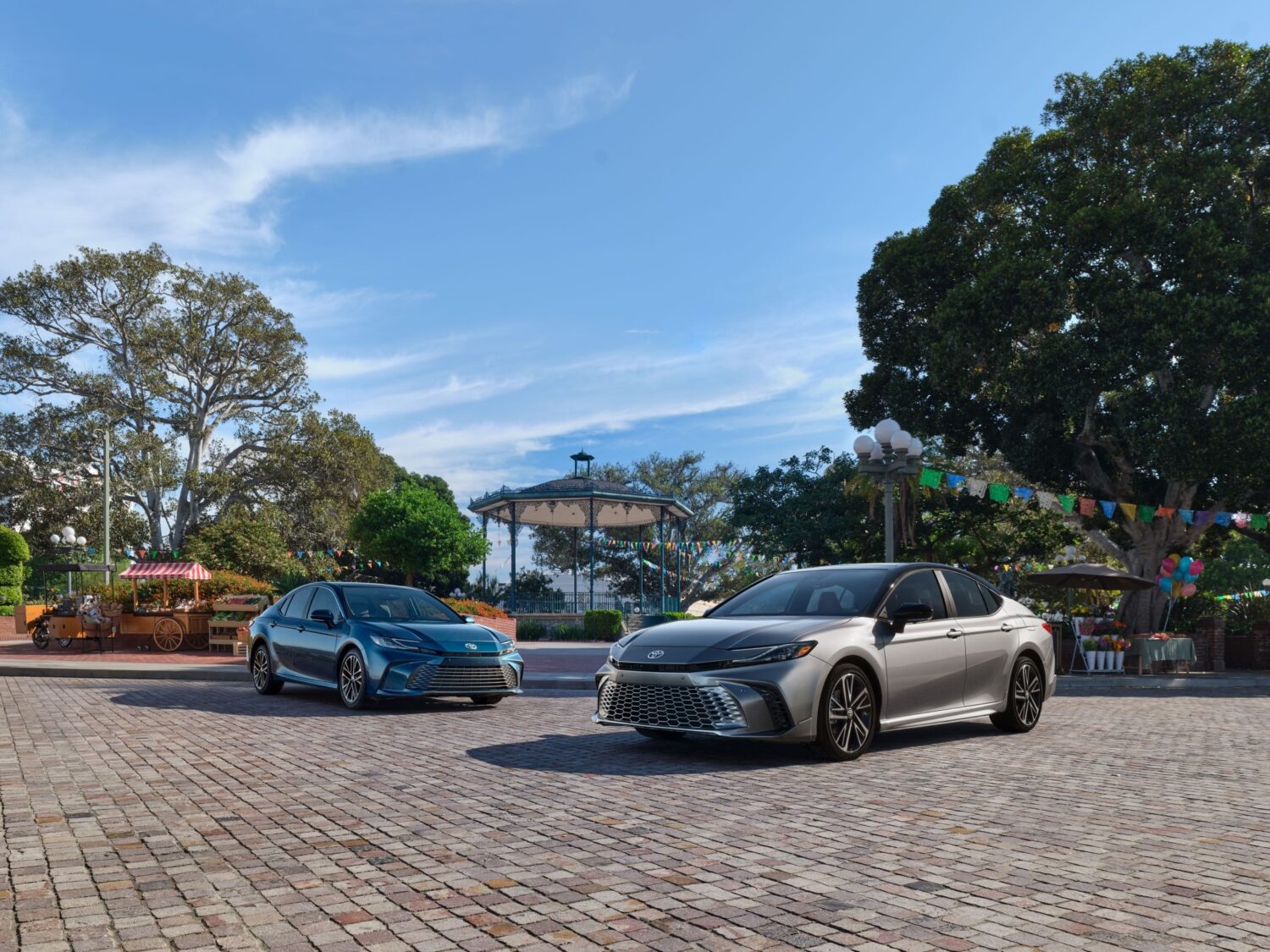
Even if you never get to see it in Nigeria, at least you'd know what you're missing - or not. The legendary Toyota Camry has evolved into its ninth generation.
Unveiling enhanced redesign, heightened performance, and an innovative hybrid powertrain, the 2025 Camry sets the stage for a dynamic sedan segment.
Designed and built in the U.S., this car updates the beloved features of America's top-selling sedan, boasting increased power, captivating aesthetics, convenience-rich features, and agile handling.
In a groundbreaking move towards electrification, the 2025 Toyota Camry proudly stands as an exclusive Hybrid Electric Vehicle (HEV), seamlessly blending power and fuel efficiency for daily driving service.
When the car begins hitting Toyota Dealerships in the Spring of 2024, it will proudly wear the "Beyond Zero" badge—a testament to Toyota's commitment to carbon reduction and a bold stride towards a carbon-neutral future.
The 2025 Toyota Camry's Design And Trim Levels
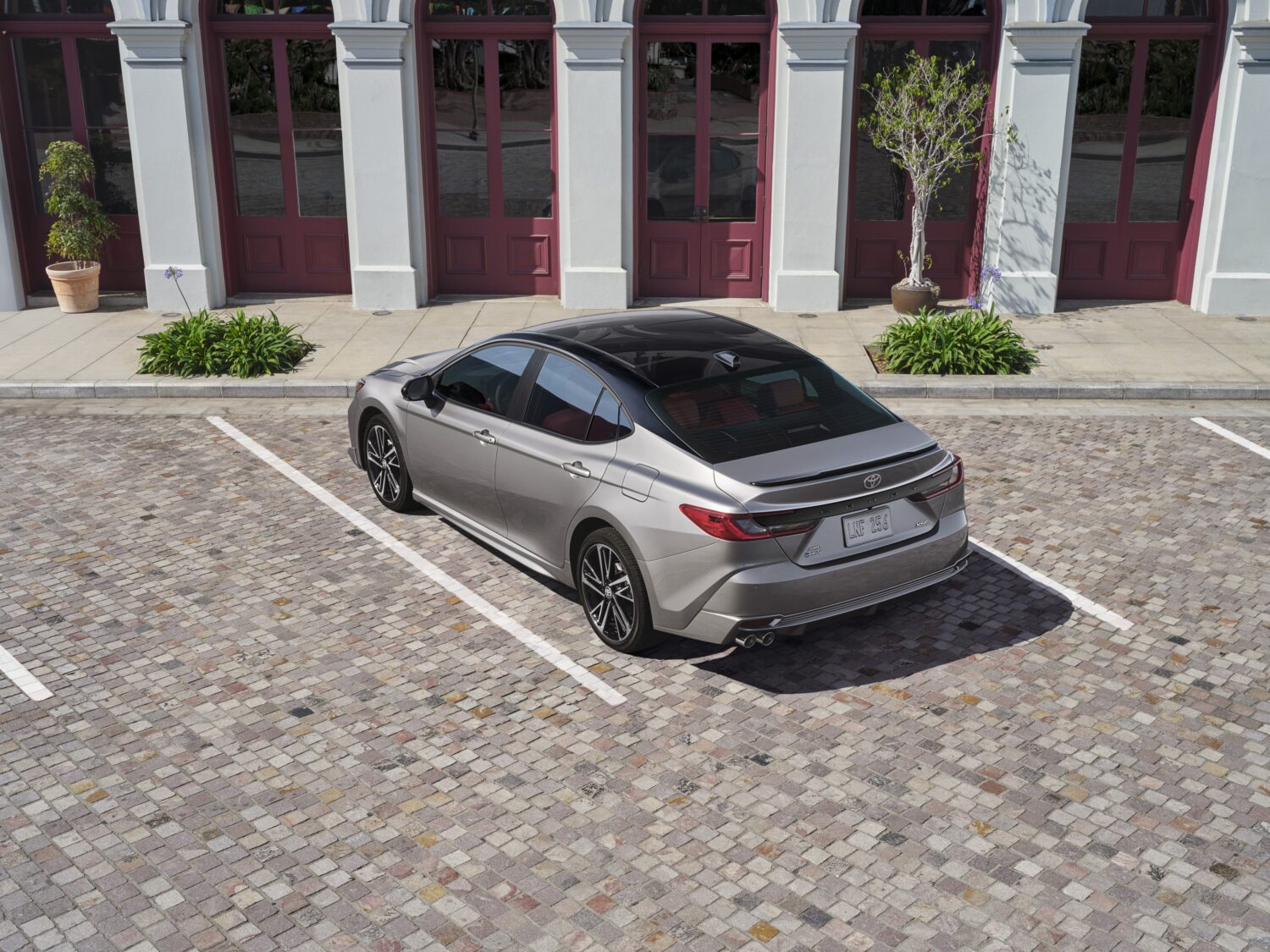
CALTY's Newport Beach and Ann Arbor studios collaboratively shaped the ninth-generation Toyota Camry, injecting the already sleek sedan with an athletic aura.
The new Camry’s hammerhead front fascia showcases a clean, modern allure destined to captivate onlookers. All the trim levels feature slim LED headlights, daytime running lights, and taillights.
The SE and XSE trims flaunt sporty exterior vibes, marked by a streamlined roofline and a finely chiseled body. Racing-inspired functional aerodynamic air ducts, front-side canards, and a rear diffuser contribute to the sporty allure, complemented by an exposed dual-tip exhaust and a rear lip spoiler.
A unique color-matched front grille and black trunk garnish further elevate the XSE's sportier styling. Moreover, the SE’s 18-inch multi-spoke black-finished alloy wheels and the XSE’s 19-inch multi-spoke black and smoke gray-finished alloy wheels immediately stand out to discerning eyes.
A Riot of Colors
The 2025 Camry offers a satisfying palette of exterior colors, including the newly introduced Ocean Gem and Heavy Metal, alongside Camry classics like Ice Cap, Wind Chill Pearl, Celestial Silver Metallic, Underground, Midnight Black Metallic, Supersonic Red, and Reservoir Blue.
The XSE grades offer an enticing two-tone option, pairing Ocean Gem, Wind Chill Pearl, Heavy Metal, and Supersonic Red with a Midnight Black Metallic roof. This fusion of design and color options ensures that the 2025 Toyota Camry is just as much a statement of style as it is innovation.
2025 Toyota Camry Interior Design
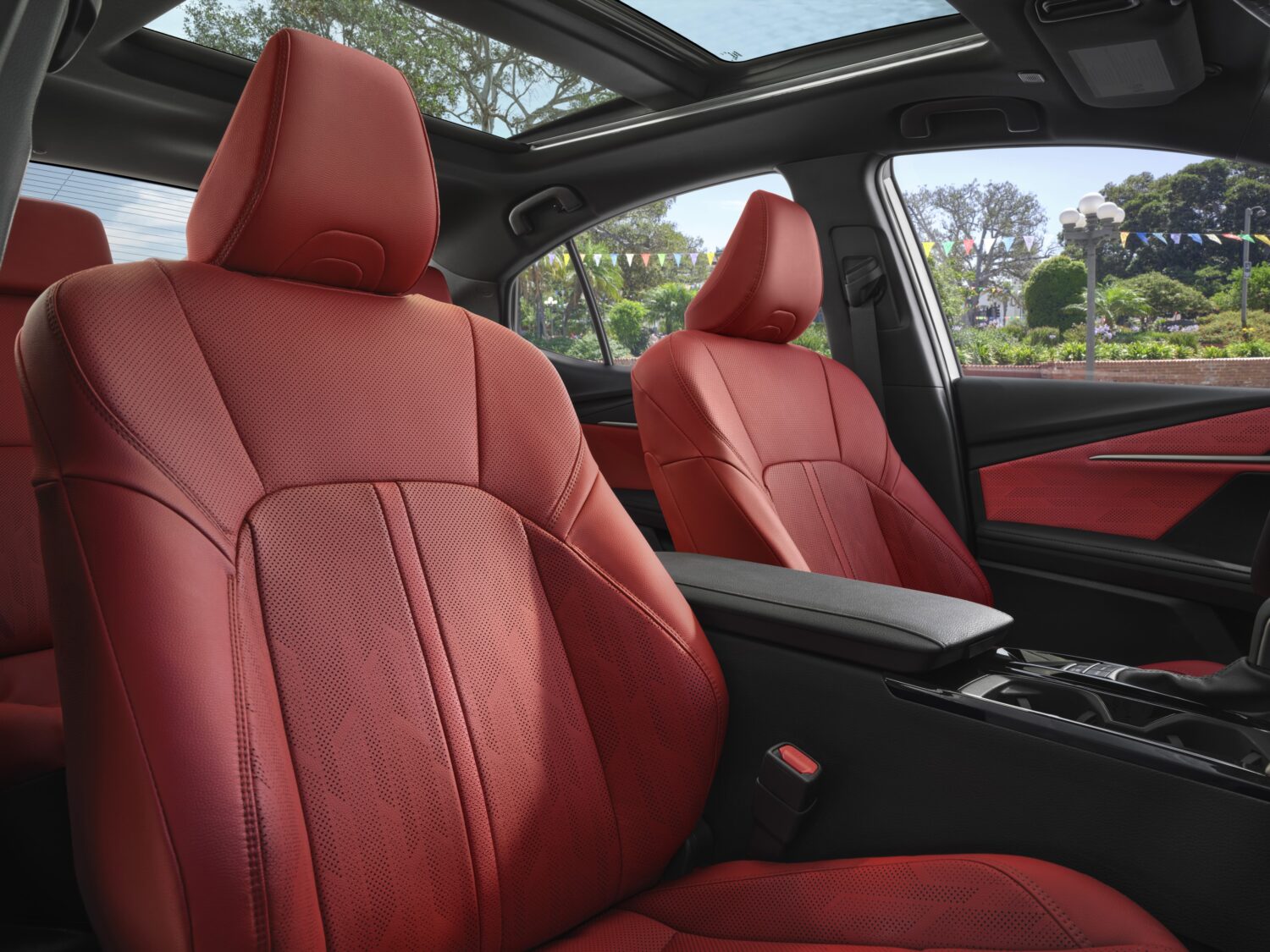
In the sport-focused SE, SofTex®-trimmed seats showcase bold white accents in Boulder or Black, while the XSE elevates the experience with standard leather-trimmed seats featuring an artistic “shooting blade” patterned perforation.
Customers can choose from Black with blue-lined perforations or the captivating Cockpit Red.
Both SE and XSE boast standard aluminum sport pedals and a leather-wrapped steering wheel with paddle shifters for a dynamic driving feel. The comfort-oriented LE embraces an ocean-inspired interior, with an embossed pattern in woven fabric adorning the trim and seats in Boulder or Black.
The premium XLE takes luxury a step further, introducing leather and Dinamica® microfiber-trimmed seats in Light Gray or Black, featuring a quilted pattern on the front door panels and dashboard.
The 9th-gen Camry will come with updated cabin comfort as Toyota engineers redefine cushion shape and density, lengthening the seat for an improved driving experience.
The headrest's rearward adjustment improves seat and ride comfort, a feature extended on the XLE and XSE with available three-level front heated and ventilated seats.
The 2025 Camry top trim owners will enjoy a quieter cabin experience, thanks to standard front-side acoustic laminated glass, reducing wind noise and harshness.
The standard smart-key and push-to-start features herald Toyota's commitment to optimized user experience. The dual-zone automatic climate control system with rear air vents promotes a comfortable journey for every passenger.
The XLE goes the extra mile by offering a driver's memory seat and memory side view mirrors for households with multiple drivers. The new Camry will also offer the convenience of automatic rain-sensing windshield wipers, a thoughtful addition to the XLE.
For the first time on a Camry Hybrid, owners have the option of a power tilt and slide panoramic roof with a power-retractable sunshade on the XLE and XSE grades, bringing the beauty of the outdoors inside your driving experience if you so choose.
See also: The Nissan Maxima Will Look And Behave Radically Different In 2025
2025 Toyota Camry's Infotainment And Technology
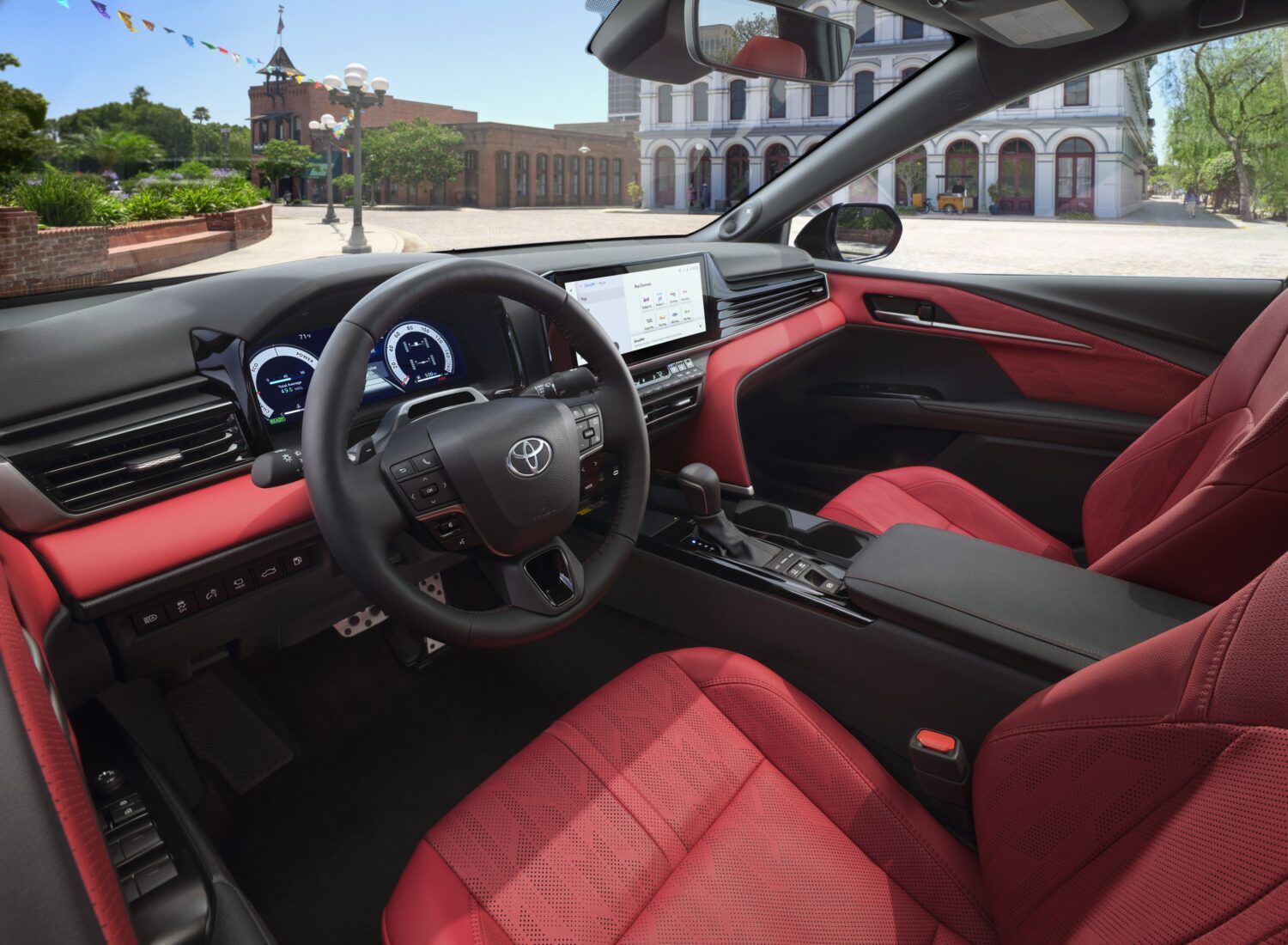
For the 2025 Camry MY, a 7-inch digital gauge cluster comes standard on LE and SE models, while the XLE and XSE come standard with a 12.3-inch fully digital gauge cluster.
The XLE and XSE grades also come with an available 10-inch Head Up Display where drivers can more safely observe their speed, warning indicators, and turn-by-turn navigation.
The Toyota Audio Multimedia System includes a standard 8-inch touchscreen display or an available 12.3-inch screen. The system includes standard wireless Apple CarPlay® and Android Auto™ compatibility and pairs well with the standard Qi wireless charging pad.
The Camry also offers a standard combination of USB-A and USB-C ports, with three in the front and two in the rear across all trim levels.
The 2025 Toyota Camry will also offer access to a wide range of enhanced connectivity features, including the Toyota Audio Multimedia with dual Bluetooth® phone connectivity. A Wi-Fi Connect (trial/subscription) offers 4G connectivity for up to five devices (30 day/3GB trial included).
With active Drive Connect (trial or subscription), Camry drivers can also interact with the system through touch and voice activation.
With Intelligent Assistant available through Drive Connect, simple phrases like "Hey Toyota" awaken the system for voice-activated commands to search for directions, find Points of Interest (POI), adjust audio controls, change cabin temperatures, and more. Over-the-air (OTA) updates will also be available.
Supplementing the already robust audio playback techs includes HD Radio, a SiriusXM® Platinum Plan 3-month trial subscription, and integrated streaming, allowing you to link separate Apple Music® and Amazon Music subscriptions.
For audiophiles who will settle for nothing less than premium sound, the new Camry offers a nine-speaker JBL® Premium Audio system upgrade.
Furthermore, the 2025 Camry’s up to 10-year Safety Connect trial includes an Emergency Assistance Button (SOS), 24/7 enhanced roadside assistance, automatic collision notification, and a stolen vehicle locator.
The included Service Connect trial (up to 10 years) updates owners with vehicle health reports, maintenance alerts, and reminders. In addition to the standard smart key functionality, the XLE and XSE trims offer an optional Digital Key.
With an active Remote Connect (trial or subscription), drivers can use the Digital Key via the Toyota app to control access to the car, including the trunk, as well as start the car using a smartphone as the key.
2025 Toyota Camry Safety And Driver-Assist Features
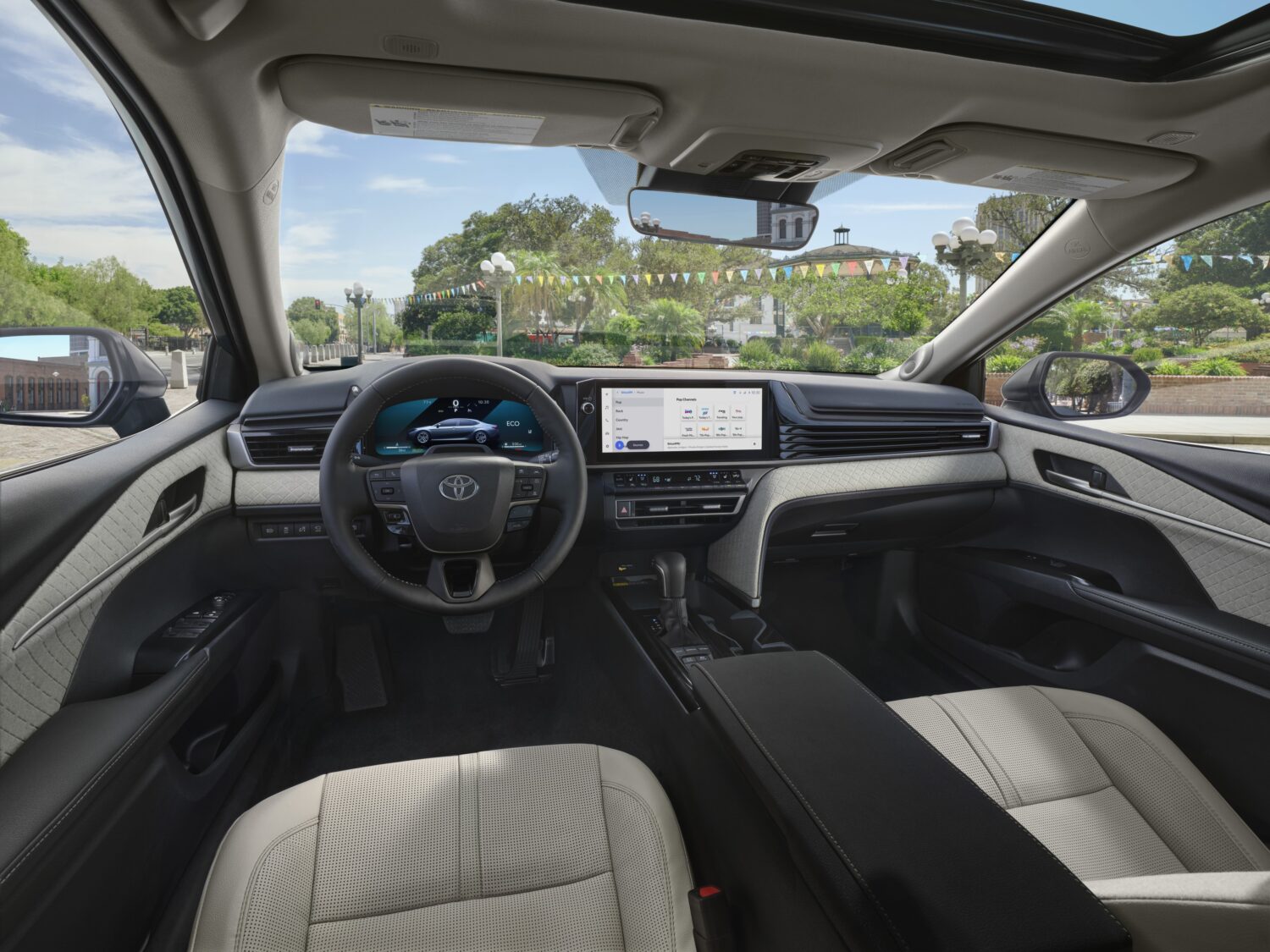
The 2025 Toyota Camry comes standard with a Blind Spot Monitor, designed to help detect and warn drivers about vehicles approaching or positioned in the adjacent lanes, while the Rear Cross-Traffic Alert detects vehicles approaching from either side while backing out and alerting you with a visual and audible warning.
The XLE and XSE grades come available with a Premium Plus Package with expanded driver aid functions, which includes features such as:
- Traffic Jam Assist
- Front-Cross Traffic Alert
- Lane Change Assist
- Panoramic View Monitor
- Front and Rear Parking Assist with Automatic Braking
Notably, the 2025 Toyota Camry comes standard with Toyota Safety Sense 3.0 (TSS 3.0), including:
- Pre-Collision System with Pedestrian Detection (PCS w/PD): This is designed to help detect a vehicle, pedestrian, bicyclist/motorcyclist and provide an audio/visual forward collision warning under certain circumstances. If you don't react, the system is designed to provide automatic emergency braking.
- Full-Speed Range Dynamic Radar Cruise Control: Intended for highway use, Dynamic Radar Cruise Control (DRCC) is an adaptive cruise control system set at speeds above 20 mph and uses vehicle-to-vehicle distance control to help maintain a preset distance from the vehicle ahead of you.
- Lane Departure Alert with Steering Assist (LDA w/SA): When white/yellow lane markings or certain road edge boundary lines are detected at speeds above 30 mph, LDA w/SA issues an audio/visual lane departure warning if an inadvertent lane departure is detected. If the driver does not take corrective action, the system is also designed to provide gentle corrective steering for lane-keeping assistance.
- Lane Tracing Assist (LTA): When Dynamic Radar Cruise Control (DRCC) is enabled and lane markers are detected, LTA uses the lines on the road and/or preceding vehicles to provide active driving assistance and help keep the vehicle centered in its lane.
- Road Sign Assist (RSA): Using an intelligent camera, RSA detects speed limit, stop, Do Not Enter, and other warning signs, displaying the sign's symbol on the Multi-Information Display (MID).
- Automatic High Beams (AHB): This helps drivers see more clearly at night at speeds above 21 mph. The AHB system detects the headlights of oncoming vehicles and taillights of preceding vehicles, then automatically toggles between high and low beams accordingly.
- Proactive Driving Assist (PDA): PDA uses the vehicle's camera and radar (provided system operating conditions are met) to provide gentle braking and/or steering to support driving tasks such as distance control between your vehicle and a preceding vehicle, pedestrian, or bicyclist. PDA can also provide gentle braking into curves.
The 2025 Toyota Camry's Engine And Performance
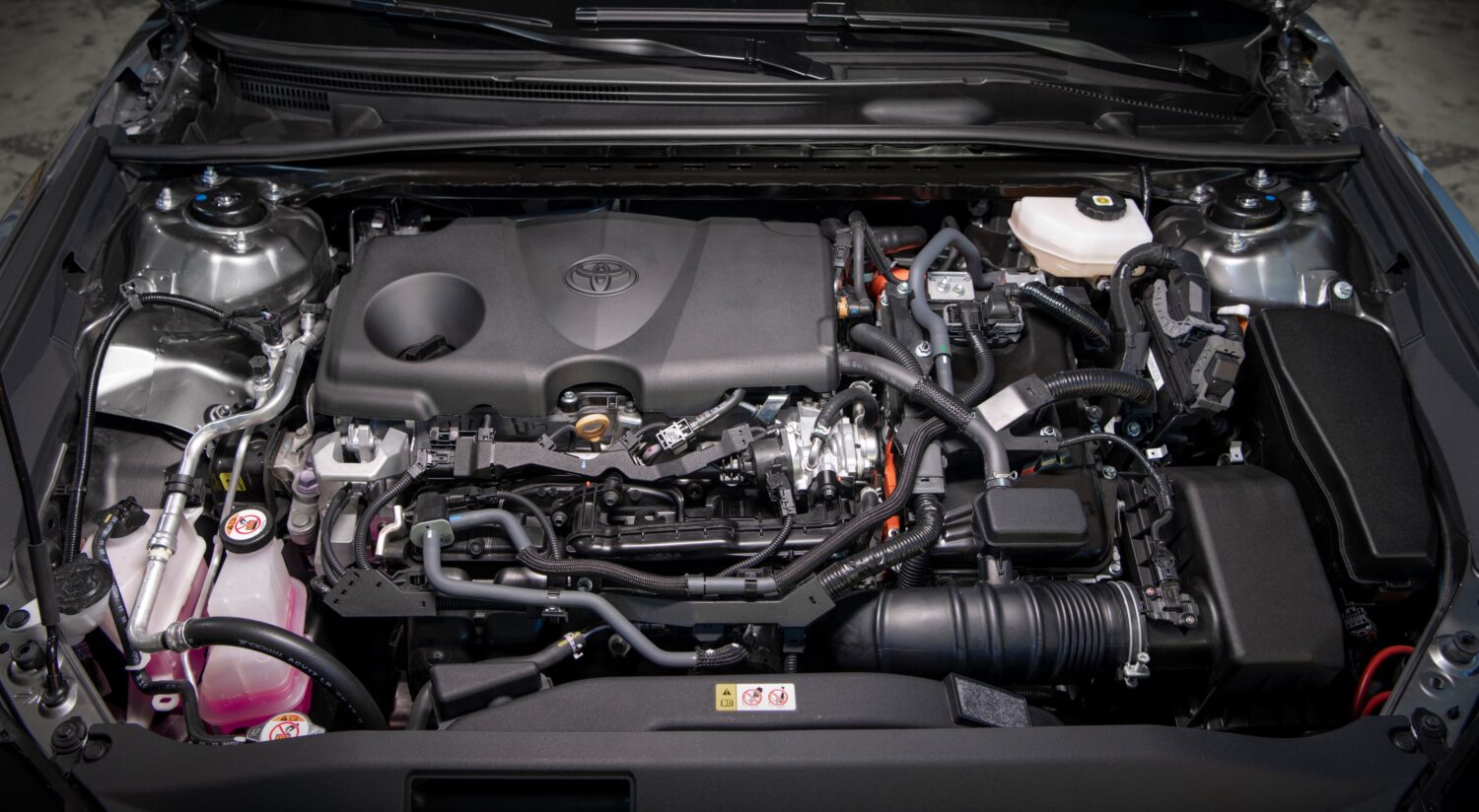
Propelling the 2025 Toyota Camry is a groundbreaking combination of Toyota's 2.5-liter, 4-cylinder engine and the cutting-edge fifth-generation Toyota Hybrid System (THS 5).
Engineered for optimal performance, the hybrid system has been finely tuned at lower speeds, reducing engine RPMs and amplifying power from the traction battery, delivering a gratifying acceleration and torque experience.
This innovative system incorporates lighter and more compact electric motors, surpassing the capabilities of its predecessor and producing enhanced power and performance.
THS 5, when joined by Toyota's Electronic On-Demand All-Wheel Drive (AWD) system, achieves an impressive 232 combined horsepower – a notable 30-horsepower increase from the current generation with a mechanical All-Wheel Drive system.
The electronic On-Demand AWD seamlessly integrates with the hybrid system to deliver precise front-rear torque distribution based on driving conditions. This ensures optimal support for start-off acceleration, handling, fuel efficiency, and stability on slippery surfaces.
To complement these advancements, the Camry boasts a retuned suspension, enhancing responsiveness and agile handling on winding roads. For the Camry SE fans, the sport grades feature a specific sport-tuned suspension that not only enhances comfort but also improves stability and confidence behind the wheel.